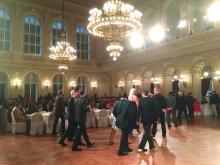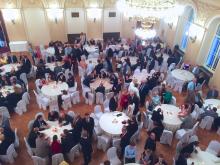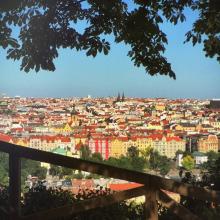CEORL 2015 Prague
We just wrapped up the excellent 3rd meeting of the Combined European OtoRhinoLaryngological Society (CEORL) in the city of Prague, Czech Republic.
CEORL 2015
Prague Congress Center: an excellent location, if not quite in the heart of the city, within a healthy walking distance. Guarant, the organizers included a transportation pass. It was not even necessary to pull it out, just hop on any transit and go. The subway was efficient. I personally enjoyed staying at Hunger Wall Residence in Mala Strana at an apartment where I could live like a local. I'll admit that my bias is to attend meetings in large cities and avoid meetings at resorts. I enjoy the local culture and cuisine and getting out after the meeting. Prague is a spectacular city. The venue was immediately adjacent to Vyšehrad, one of Prague’s castles, in a quiet location for a walk or early morning run with views up (Hradcany castle) and down the Vltava river.
In this regard, the Gala dinner (and probably the presidential dinner which I missed out on) were held in beautiful, historical palaces. It was truly grand to wander around inside Zofin Palace, rubbing shoulders with all the nobility present at the meeting (at least everyone looked noble). I wandered around for a bit just listening to all the various languages being spoken by each pod of individuals. Yes, the bulk of physicians speak passable English and English is the default language, but it still doesn’t hurt to have more than one language at your command if you truly want to communicate well. The settings for Gala dinners in Europe continue to surpass any that I attend in the US. At €90, I was happy to pay for this event. The cuisine was dedicated to Czech food. It was rather fun to consume a fruit gelatin dipped in whipped cream and frozen in a pool of liquid nitrogen. Not being a wine drinker, their non-alcoholic drinks were delightful, including the cucumber punch. Depending on which floor you gathered, you could dance to Pop music like ABBA in the main hall, Moravian music at the entrance or stand outside on the balcony in the prolonged summer twilight.
Like most events, I continue to learn the most in the hallways, bumping into people and making conversation even when it requires the effort of a new introduction, understanding each other's strong accents, and the give-and-take of language until we are both on a similar wavelength for conversation. These hallway chats are sometimes triggered by having heard the lecture first, then bumping into the speaker later, or by having delivered a short talk and having an audience member ask questions afterwards outside the door, or having an acquaintance introduce me to someone who has an interest that closely parallels my own. In that regard, I ran into Antoine Giovanni (Marseille) on a panel for surgical feminization of the voice who reintroduced me to Jean-Paul Marie (Rouen) and I ended up in Jean-Paul’s fascinating lecture on reinnervating the abductor muscles of the larynx. Truly fantastic videotaped results of once static vocal cords now opening when the individual wants to breathe. This is a rare feat in laryngology. His was the last lecture of the day and rather poorly attended.
The organizers had put a price of €15 on instructional courses and placed instructional courses first thing in the morning at 8 AM and again in the evening at 5 PM. At €15 each, even physicians are quite cheap and tend not to attend the instruction courses in the same numbers that they attend the one price included, middle of the day sessions. First and last of the day timing and the price seemed to lower attendance at every instruction course I attended. So, from a presenter’s point of view, those of us who had prepared a 45 minute session were left with small, and perhaps dedicated audiences, but it sure seemed like quite a bit of work and travel for a small turnout. Additionally, by pricing these courses separately, as an audience member, in the event of a mis-chosen lecture, there was a disinclination to leave and try to find a better topic, which would require heading over to the check-in area and making another payment, all the while missing more of the content of the next lecture. Note to the organizers, raise the price of the whole meeting and make every session included.
The A/V team was outstanding and kept almost every lecture running. It still takes extra persuasion to get them to avoid using their system and allow a MacBook to plug-in. Their system still ended up dropping my audio without explanation in the middle of the presentation but we coped with it, using an extra microphone adjacent to the computer speakers (mine wasn't the only presentation that had this difficulty). They really want everyone to use PowerPoint (which I do not) and upload their presentations to their system. I still find that my videos work much more consistently on my own computer and appreciated that they were willing to test my system and work with me. In the end, they were one of the better run A/V companies I have worked with.
Marc Remacle (Louvain) put together a number of sessions, including the voice feminization session where vocal cord webbing (aka Wendler procedure), cricothyroid approximation (laryngoplasty type IV), laser vocal cord tuning (LAVA is one variant) and feminization laryngoplasty were discussed. Panel members included Marc Remacle (Belgium), Andrea Ricci-Maccarini (Italy), James P. Thomas (US), Antoine Giovanni (France) and Guri Sandhu (UK). Later in the afternoon, at one of those lightly attended evening instructional courses, Ismail Kocak (Turkey) discussed his combination of cricothyroid approximation and laser reduction or tuning glottoplasty. Ahmed Geneid (Finland) also presented their glottoplasty experience. So through a combination of roundtables, instructional courses and lectures it was possible to get a broad, if still incomplete, overview of the evolving art of vocal pitch change. My commendations to Marc who not only ran the entire meeting as president, but put together a number of lectures and roundtables.
Frederick Dikkers (Netherlands) presented some surgical incidence curves for papilloma surgery before and after quadrivalent HPV vaccination. Potentially interesting material, not yet proven, but a hint that vaccination after exposure may still have some benefits.
There is still an awful lot of science "hoping for a positive benefit" on the hoarse voice from antireflux treatment, finding none, but still concluding that "trends point to" or "we just need to test longer". Some studies still lump multiple symptoms (cough, lump, hoarseness, drip) into a single project and find no benefit. I was informed there are over 900 indexed articles on reflux laryngitis. Some ideas just survive, despite a lack of evidence.
Several of the exhibitors were kind enough to distribute espresso and other small snacks to fill in the gaps, but really the organizers had plenty of food available at every break. Breaks were frequent throughout the day and these intermissions presented a great chance to chat while moving between rooms. My thanks to Olympus & Cochlear for these little but much appreciated extras. I ate plenty of your biscotti.
Olympus is introducing some exciting new technology. I'm looking forward to 4K video examinations of the larynx which appears to be on the horizon. It is interesting how spread out the quality of endoscopic examinations are now, with high-definition video available, yet much of the laryngology world still using flexible fiber-optic scopes. Karl Storz and XION had some very high quality and cost conscious chip endoscopes for laryngeal exams. The small diameter flexible chip endoscopes by Olympus and XION are small enough that many physicians can maneuver the endoscope quite close to the larynx, even without topical anesthesia. I had the opportunity to see them in use while in Prague.
I will be attending this meeting again in the future.







